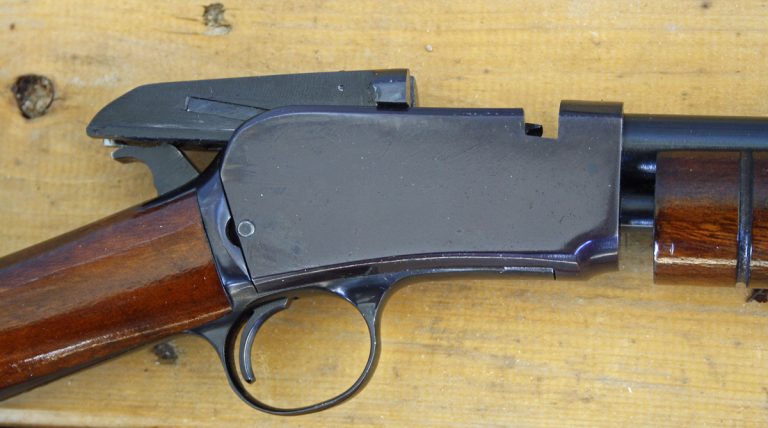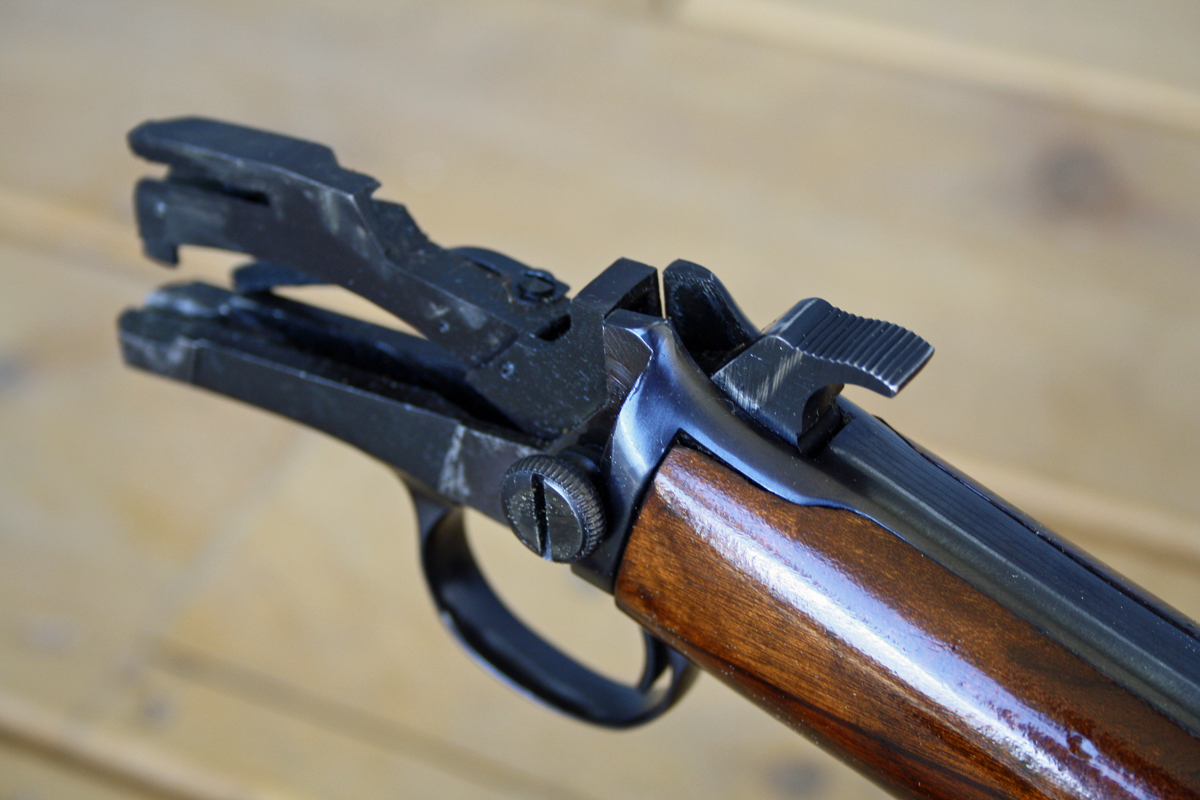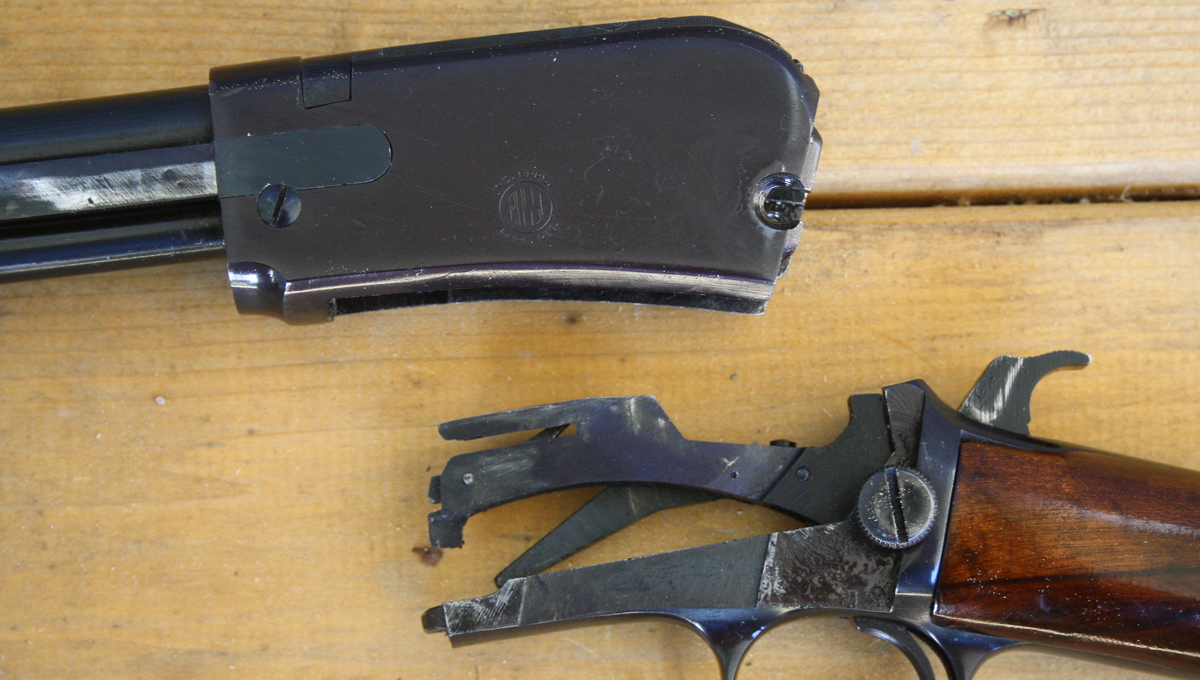
How’d you like to own a classic Winchester rifle, for under $500? That’s basically impossible these days, as even beater post-64 Model 94 carbines now regularly sell for that, or more. It gets even more silly if you want a vintage rimfire repeater like a Model 62. You can either pay crazy money for a collector’s gun, and then be afraid to shoot it because you don’t want to rough it up. Or, you can pay slightly less-crazy money for a beat-up shooter, and then be afraid to shoot it because it’s worn out and likely to break.
Or, you can buy a Rossi 62. It might not have the Winchester name on the barrel, but it’s the same design as the pump-action rimfire rifle, and just as much fun to shoot.
John Browning’s brainchild
The .22LR Winchester rifle that Rossi copied was originally a John Browning design. In the late 1800s, Browning thought pump action was the future, not lever action. The Model 1890 rimfire rifle was one of his earliest attempts. A second, similar model joined the lineup more than a decade later, the Model 1906. The Model 62 came along in 1932, also the same basic design. When Model 62 production ended in 1958, Winchester had built almost 2 million rifles along this pattern.

That’s a long production run, and a lot of rifles. Why was it so popular? Browning’s design was successful for two basic ideas: The pump-action rifles were fun to shoot, and they got into the hands of the right people. Professional trick shooters showed what the gun could do, and then kids went out and shot the exact same gun in shooting galleries.
Shooting galleries using real firearms were considered perfectly reputable entertainment in the early 1900s, set up at carnivals and fairs. Pay the carnies, and blast away for a chance at a prize (often not using full-power .22LR--many of these guns came chambered in .22 Short).
They were popular with hunters and general shooting enthusiasts, too. Semi-auto rimfires weren’t as prevalent in the first half of the 20th century; pump-action .22s were fast-shooting, and able to handle just about any kind of ammunition.
However, like most vintage Browning designs, these guns were not aimed at dumbed-down mass production, which made them more expensive to manufacture and more fiddly to fix. With its open-top action, you couldn’t easily mount a scope to the Model 62. And, in the Baby Boom years, the market moved towards semi-autos. It’s no surprise Winchester dumped the Model 62 in the late ‘50s--if anything, it’s a surprise the design lasted that long, and a testament to just how good and how much fun these rifles are.
The Brazilian connection
Most of the American gunmakers had built pump-action .22s in the first half of the 20th century, but by the 1970s, only Remington was still in the game, with the Model 572 Fieldmaster. And then, the Rossi Model 62 started to appear on the market. It was basically the same gun as the Winchester Model 62, but made in Brazil and imported to North America through Interarms.
No doubt some shooters were suspicious of the Rossi brand, as it wasn’t exactly a household name back then--at least, not in North America. The Amadeo Rossi SA factory had a long history of its own, though, building firearms in São Leopoldo all the way back to 1889.
In a way, Rossi was just carrying on a time-honoured tradition with the Model 62. Overseas factories, particularly in Spain, had been copying North American “cowboy guns” for decades. In some cases, like the El Tigre carbine (a copy of the Winchester 1892), production numbers ran over a million rifles built.
Changes to the formula
The Rossi Model 62 is mostly faithful to the original John Browning design. It’s a takedown rifle; a knurled screw on the left side of the receiver splits the rifle into two pieces, a common feature on older sporting firearms. This allowed for easier storage, and made the rifle easier to transport in cramped railway luggage.

There’s no lawyer-friendly safety on the Rossi Model 62; the hammer has a half-cock position instead. The ribbed forearm connects to a single action bar; push the bolt backwards, and it lifts out the rear of the receiver as it ejects an empty casing and lifts a fresh cartridge from the magazine. Pump the forearm forward, and the bolt drops back into the receiver, locking at the front as the cartridge is pushed into the chamber.
Like other classic pump-action designs, the Rossi Model 62 has no trigger disconnect. This means you can hold the trigger down, and the rifle will fire as fast as you can pump the forend. This slamfire feature has zero usefulness on a rimfire rifle, but it’s a fun way to do a mag dump once in a while.

Loading the Model 62 is easy, via a familiar under-barrel tube mag. Rifles with a 23-inch barrel will hold 14 rounds of .22LR.
However, not all these Rossis came with a 23-inch barrel, and not all were chambered in .22LR. Some came with a 16-inch barrel, a much more compact arrangement. And, some were chambered in .22 magnum. Some came with octagon barrels as well.
Rossi also sold the Model 62 with either a blued or stainless finish. Hardcore Winchester fans will say the original rifles had a better finish, but the Rossi rimfires look much better than many of the el-cheapo .22 semi-autos on the market today.

Some hardcore Winchester fans will also say the original rifles shoot better than the Rossi copies. Not all will hold to this belief, though; it seems Rossi Model 62 production did not have great quality control, and some are actually more accurate than the Winchester originals, while others exhibit less-than-stellar precision.
On inaccurate Rossi rimfires, the crude sights are part of the problem. I’ve seen these rifles with decent irons, but others have cheap sights best-suited for a water pistol or capgun. Rossi’s tendency to use odd-shaped sight dovetails makes the problem worse, as it’s not always easy to swap out a better sight system. If you look around long enough, there are solutions on the market, though. One popular upgrade from past years was a tang sight, originally designed for a Rossi lever-action. However, it seems this sight is basically unobtanium now, as it’s been discontinued.
The new Model 62
The Rossi Model 62 was never a huge seller in North America, but there seems to have been a relatively steady supply through the 1970s and 1980s, at least. They’re not common, but they’re not that rare, either. If you want one badly enough, you should be able to find a decent example for $450 or less, depending on condition (although prices are rising, as always).
Rossi seems to see a demand for the rifle, though, because the company revived the Model 62 at the 2020 SHOT Show … except it isn’t really a Model 62.
Looking at photos from last year’s SHOT Show, the new Model 62 is a pump-action .22LR with exposed hammer, but the rest of the rifle looks very different from the classic John Browning design. There’s an ejection port on the side of the receiver, which makes scope mounting easier, but it definitely isn’t the original layout. It comes in several different versions, including one with a synthetic stock and fiber-optic sights.There’s a cross-bolt safety, and an ugly slide release in front of the trigger guard. It’s not a takedown rifle, either.
The new rifle will likely generate some interest, as pump-action .22s are hard to find these days. But, if you want the original John Browning classic, keep your eyes open on used gun sales websites--you should be able to find the older Rossi for roughly the same money, and its vintage design comes with some advantages of its own.